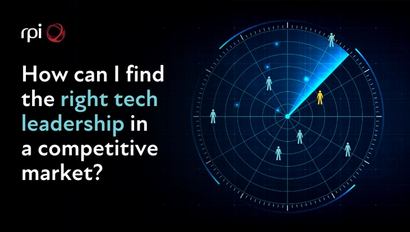There is far more to cyber security than technology and architecture. To make cyber security initiatives a success, there needs to be awareness and understanding of cyber policies, process and priorities across the entire business.
Organisations with the most robust cyber security practices have a constantly changing security agenda: an in-built awareness of the importance of cyber security, the ever-changing threats they face and the role it plays in digital growth.
Yet these businesses don’t get to that point of adoption overnight. They have been taken on a journey, one that reaches all of the necessary touchstones to enable cyber security to become an integral part of their business, and their plans for the future.
At RPI, we often partner with businesses while they are on that journey, ensuring that they have the right talent they need at every step to ensure that their business can integrate cyber security solutions that are effective, reliable and flexible.
So what should that journey look like? The destination may be different for every business, but there are certain points that every organisation needs to explore in order to secure a strong, protected digital future.
Step one: Understanding the long-term need for cyber security
Why do you need to change your current cyber security measures, and why now? This is often the first hurdle that businesses face, as cyber security teams or leaders attempt to secure buy-in from the board. There is a common attitude of “The business is doing well, revenue is accelerating, our market share is growing…why change things now?”
Yet businesses who don’t stop and reflect on cyber security during periods of growth and prosperity are dicing with danger. Retrospectively trying to implement security measures in well-established business functions is a much harder task than building them in from the start of a new project – and each new digital development exposes the business to new risks and vulnerabilities.
Businesses need to understand why cyber security measures are so important to every aspect of their growth in the digital age, and recognise the impact that data breaches, hacks or other cyber threats could have on their business.
Step two: Leadership
The impetus to drive understanding and awareness of cyber security risks and safeguards needs to come from the top of a business if it’s going to trickle down to every employee. In short, cyber security needs to be championed at board level: whether that’s through backing from the CEO, official incorporation into the CIO role, or via a specific cyber security lead in the c-suite.
Cyber security underpins every part of digital development: to secure their digital future, businesses need to make cyber security roles part of the leadership team, as opposed to reporting to the board. This step changes the mindset of the business, to engrain cyber security into the fabric of the organisation, in much the same way that Chief Data Officers have reframed businesses relationship with data.
Step three: Integrating cyber security into business objectives
Cyber security is not an IT issue. Yes, there are elements of it that need to be facilitated by IT teams, but cyber security should be the responsibility of the entire organisation – and led by a dedicated team. Following on from incorporating cyber security advocates at leadership level, the function of cyber security needs to be extracted from IT and prioritised as its own entity.
Sometimes this can be a subsection of the IT department, which can work if the CIO is security conscious and able to develop a dedicated team with the leadership, resources, budgets and skills it needs to thrive. However, seconding IT professionals who aren’t cyber security specialists into that arena is a big risk: they may be able to oversee and implement the technical side of cyber security, but they won’t have the skills needed to analyse threats and lead a proactive response in a changing cyber landscape.
Step four: Skills and talent
Cyber security is one of the most in-demand skillsets in the world right now: in every sector, and across every continent. At RPI, we recently worked with a large corporation in Europe who had been facing such significant talent shortages in their cyber security projects that they had borrowed people from their infrastructure and network departments to implement cyber initiatives: people who lacked the specialist knowledge to fully integrate and adapt cyber security measures effectively.
With such fierce competition for cyber skills, businesses need to be able to tap into global talent flows to get the talent they need, when they need it. At RPI, we help businesses to acquire the talent they need to make cyber security a success, whether that’s through executive search to find cyber security leaders that can integrate at a senior level; flexible project solution implementors; permanent hires; or interim appointments.
Joining the dots: making cyber security part of the fabric of your organisation
For businesses to overcome the many hurdles that cyber security presents, and be able to respond to ever-evolving cyber threats in the years to come, they need to take this cyber security journey to ensure that awareness and understanding reaches every part of the business.
A shift away from reactionary and advisory measures, towards a proactive cyber security drive at leadership level that integrates security into the entire business, will create a more stable and secure cyber security infrastructure, for more stable digital growth.
To find out how RPI can help you on your cyber security journey – whether you’re taking your first steps or evolving an established cyber initiative – get in touch today.



